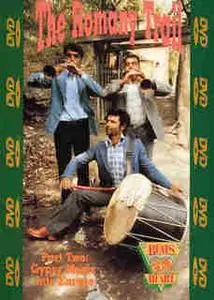The Romany Trail - A story of gypsy music - DVD2 - Europe (1981)
Documentary | English | AVI - XVID 1.1.2 29,97 fps | Subs.: none | 640x480 | MP3 256 kb/s | ~60 min | 424 Mb | Covers
Documentary | English | AVI - XVID 1.1.2 29,97 fps | Subs.: none | 640x480 | MP3 256 kb/s | ~60 min | 424 Mb | Covers
''THE ROMANY TRAIL,'' like the other ''Beats of the Heart'' music documentaries shown Mondays on WNYC/Channel 31, can make your jaw drop regularly with astonishment.
Somehow, the director Jeremy Marre manages to document musical events that most outsiders wouldn't even hear about, much less be allowed to attend; tonight's program, at 8, looks in on an Egyptian exorcism, with trance-inducing music and ecstatic dancing, and on one family's flamenco fiesta in a cave in Granada, Spain.
Culturally and geographically, the two-part ''Romany Trail'' is the most ambitious ''Beats of the Heart'' production; it examines a full-scale diaspora. In other segments of the series, Mr. Marre has looked for outcasts, and with ''The Romany Trail'' he has found three continents' worth - the people known (and, the documentary says, misnamed) as gypsies.
The two parts of ''The Romany Trail'' trace northern and southern paths of the migration; tonight's program, after a glimpse of Britain, visits India, Egypt, Spain and the Camargue region of France. Along the way, it draws connections from an Indian goddess to a Roman Catholic saint in France and, by inference, from the Egyptian rebab and Indian sarod (two kinds of bowed lutes) to the Hungarian ''gypsy'' violin.
Mr. Marre is fascinated by the way music binds communities. It articulates feelings, preserves history, mocks and defies authority. Along the Romany trail, he presents the public and private sides of each group he visits.
In northwestern India, there's a private puppet show that satirizes upper-caste society followed by a musical performance for the Maharajah himself. In Egypt, there are fortunetellers and street performers, including a man who balances a bicycle on his forehead; there's also the secret exorcism ritual.
The documentary doesn't pretend that gypsies' lives are idyllic. It finds gypsies in slums near cities, from the Hashish district near railroad yards outside Cairo - definitively the wrong side of the tracks - to a 20-year-old ''temporary'' settlement in Granada. Even in these poverty-stricken communities, there is music.
At times, the documentary uses simplistic juxtapositions. In one, a local singer of ancient epic ballads precedes Mitkail of Kena, an Egyptian folk-pop star who is presented as a sellout; gypsies selling souvenirs are shown versus a gypsy's heartfelt solo Andalusian song, performed at the mouth of a cave against a brilliant blue sky. And although the Romany tribes are united by language, across the continents and the centuries their musical styles have grown quite disparate.
Yet whether or not Mr. Marre's musicology and sociology are entirely convincing, ''The Romany Trail'' does show some of the glory, and the despair, of Romany culture. If not everything is completely pinned down -well, that, too, is true to the nomadic subject. Part 2 of ''The Romany Trail'' - from India through Yugoslavia, Hungary and Germany - will be shown next.
Review by Jon PARELES - The New York Times
May 5,1986.
RS Download part 1
RS Download part 2
RS Download part 3
RS Download part 4
RS Download part 5
For those who use RapiShare Manager, take the direct all-in-one link for the files
PWD: HUXLEY4U
My blog
and 


